ข่าวสารตลาด & มุมมองเชิงลึก
ก้าวนำตลาดด้วยมุมมองเชิงลึกจากผู้เชี่ยวชาญ ข่าวสาร และการวิเคราะห์ทางเทคนิค เพื่อเป็นแนวทางในการตัดสินใจซื้อขายของคุณ.

Artificial intelligence stocks have begun to waver slightly, experiencing a selloff period in the first week of this month. The Nasdaq has fallen approximately 2%, wiping out around $500 billion in market value from top technology companies.

Palantir Technologies dropped nearly 8% despite beating Wall Street estimates and issuing strong guidance, highlighting growing investor concerns about stretched valuations in the AI sector.
Nvidia shares also fell roughly 4%, while the broader selloff extended to Asian markets, which experienced some of their sharpest declines since April.
Wall Street executives, including Morgan Stanley CEO Ted Pick and Goldman Sachs CEO David Solomon, warned of potential 10-20% drawdowns in equity markets over the coming year.
And Michael Burry, famous for predicting the 2008 housing crisis, recently revealed his $1.1 billion bet against both Nvidia and Palantir, further pushing the narrative that the AI rally may be overextended.
As we near 2026, the sentiment around AI is seemingly starting to shift, with investors beginning to seek evidence of tangible returns on the massive investments flowing into AI, rather than simply betting on future potential.
However, despite the recent turbulence, many are simply characterising this pullback as "healthy" profit-taking rather than a fundamental reassessment of AI's value.
Supreme Court Raises Doubts About Trump’s Tariffs
The US Supreme Court heard arguments overnight on the legality of President Donald Trump's "liberation day" tariffs, with judges from both sides of the political spectrum expressing scepticism about the presidential authority being claimed.
Trump has relied on a 1970s-era emergency law, the International Emergency Economic Powers Act (IEEPA), to impose sweeping tariffs on goods imported into the US.
At the centre of the case are two core questions: whether the IEEPA authorises these sweeping tariffs, and if so, whether Trump’s implementation is constitutional.
Chief Justice John Roberts and Justice Amy Coney Barrett indicated they may be inclined to strike down or curb the majority of the tariffs, while Justice Brett Kavanaugh questioned why no president before Trump had used this authority.
Prediction markets saw the probability of the court upholding the tariffs drop from 40% to 25% after the hearing.
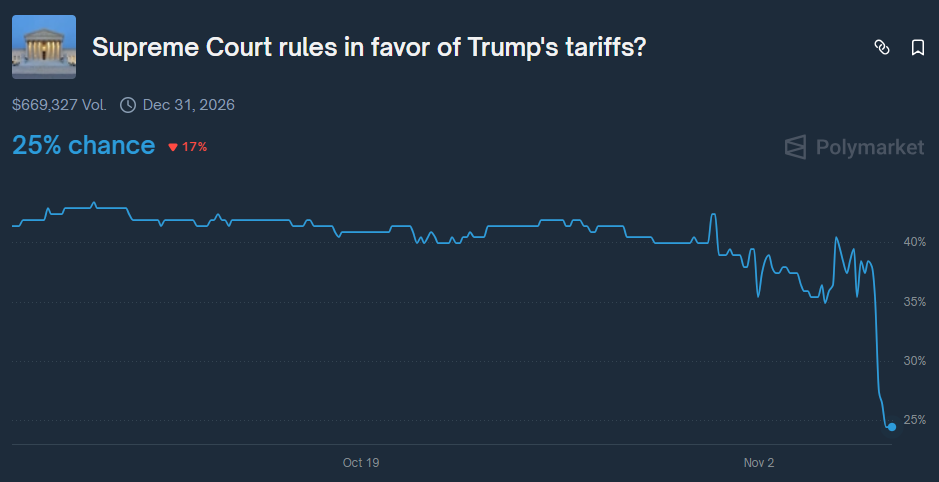
The US government has collected $151 billion from customs duties in the second half of 2025 alone, a nearly 300% increase over the same period in 2024.
Should the court rule against the tariffs, potential refunds could reach approximately $100 billion.
The court has not indicated a date on which it will issue its final ruling, though the Trump administration has requested an expedited decision.
Shutdown Becomes Longest in US History
The US government shutdown entered its 36th day today, officially becoming the longest in history. It surpasses the previous 35-day record set during Trump's first term from December 2018 to January 2019.
The Senate has failed 14 times to advance spending legislation, falling short of the 60-vote supermajority by five votes in the most recent vote.
So far, approximately 670,000 federal employees have been furloughed, and 730,000 are currently working without pay. Over 1.3 million active-duty military personnel and 750,000 National Guard and reserve personnel are also working unpaid.
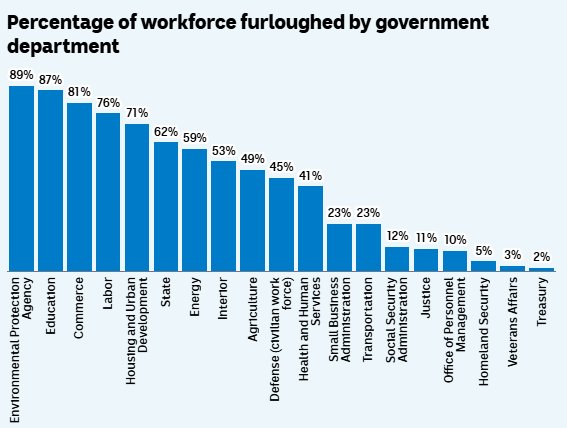
SNAP food stamp benefits ran out of funding on November 1 — something 42 million Americans rely on weekly. However, the Trump administration has committed to partial payments to subsidise the benefits, though delivery could take several weeks.
Flight disruptions have affected 3.2 million passengers, with staffing shortages hitting more than half of the nation's 30 major airports. Nearly 80% of New York's air traffic controllers are absent.
From a market perspective, each week of shutdown reduces GDP by approximately 0.1%. The Congressional Budget Office estimates the total cost of the shutdown will be between $7 billion and $14 billion, with the higher figure assuming an eight-week duration.
Consumer spending could drop by $30 billion if the eight-week duration is reached, according to White House economists, with potential GDP impacts of up to 2 percentage points total.


Barrick Gold Corporation (NYSE:GOLD) released the latest financial results for Q4 2022 on Wednesday. The Canadian mining company beat both revenue and earnings per share (EPS) for a second consecutive quarter. Barrick Gold reported revenue of $2.726 billion for the quarter vs. $2.674 billion expected.
EPS reported at $0.128 per share vs. $0.111 EPS estimate. The company also announced a dividend of $0.10 per share for Q4 2022. ''Our continued success in not only replenishing but also unlocking significant value in our asset base shows the unmatched potential of our organic growth pipeline,'' CEO of Barrick, Mark Bristow said in a press release. ''A stronger Q4 operational performance, notably from Cortez and Carlin in Nevada, Pueblo Viejo in the Dominican Republic and Tongon in Côte d’Ivoire, contributed to annual gold production of more than 4.1 million ounces in a year impacted by infrastructural issues at Turquoise Ridge in Nevada and the replacement of the rock winder at Kibali in the Democratic Republic of Congo. Copper production from Lumwana in Zambia and Jabal Sayid in Saudi Arabia was well within guidance.'' The company also announced another share buyback program: ''Barrick returned a record $1.6 billion to shareholders in 2022 through dividends and share buybacks and has announced a further share buyback program of up to $1 billion for the next twelve months.'' Stock reaction The stock was down by around 3% at the open in the US at $17.22 as share.
Stock performance 1 month: -3.10% 3 months: +12.79% Year-to-date: +3.67% 1 year: -19.88% Barrick Gold stock price targets BNP Paribas: $19 Barclays: $26 RBC Capital: $20 Goldman Sachs: $18 BMO Capital: $28 Barrick Gold is the 572 nd largest company in the world with a market cap of $31.38 billion. You can trade Barrick Gold Corporation (NYSE:GOLD) and many other stocks from the NYSE, NASDAQ, HKEX, ASX, LSE and DE with GO Markets as a Share CFD. Sources: Barrick Gold Corporation, TradingView, MarketWatch, MetaTrader 5, Benzinga, CompaniesMarketCap
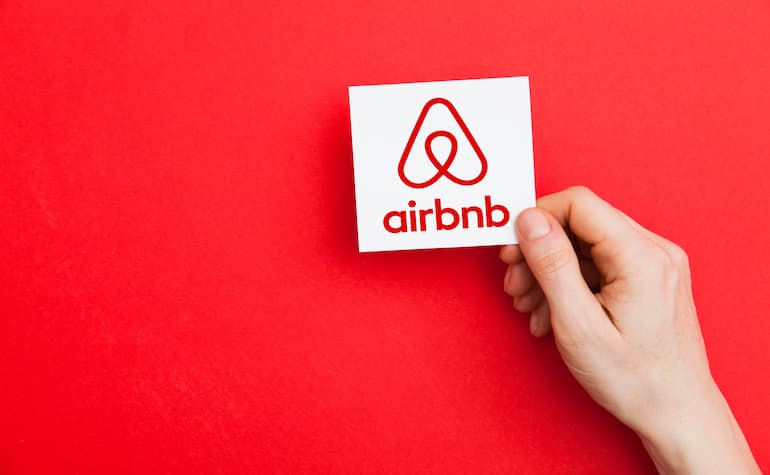

Airbnb Inc. (NASDAQ:ABNB) announced Q4 2022 and 2022 full year financial results after the market close in the US on Tuesday. World’s second largest travel company reported revenue of $1.902 billion (up by 24% year-over-year), beating analyst estimate of $1.861 billion. The revenue reported was the highest for a Q4 in Airbnb’s history.
Earnings per share also topped analyst estimate at $0.48 per share vs. $0.256 earnings per share expected. Revenue in 2022 reported at $8.4 billion, up by 40% vs. 2021. CEO commentary ''2022 was another incredible year for Airbnb.
We made almost 100 upgrades to our core service, saw record guest demand, and ended the year with our highest-ever number of active listings globally,'' co-founder and CEO, Brian Chesky said in a press release. Stock reaction Shares of Airbnb closed at $120.49 a share on Tuesday, up by 3.28%. The stock rose by around 9% in the after-hours as Q4 results came in above estimates.
Stock performance 1 month: +19.35% 3 months: +12.95% Year-to-date: +41.37% 1 year: -32.88% Airbnb stock price targets B of A Securities: $130 Barclays: $105 UBS: $114 Wells Fargo: $130 Goldman Sachs: $87 Mizuho: $110 Morgan Stanley: $80 Baird: $100 Airbnb is the 188 th largest company in the world with a market cap of $76.53 billion. You can trade Airbnb Inc. (NASDAQ:ABNB) and many other stocks from the NYSE, NASDAQ, HKEX, ASX, LSE and DE with GO Markets as a Share CFD. Sources: Airbnb Inc., TradingView, MarketWatch, Benzinga, CompaniesMarketCap
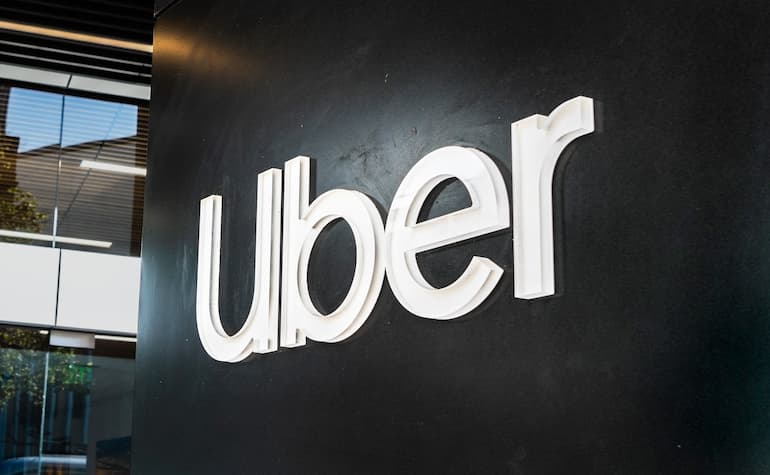

Uber Technologies Inc. (NYSE:UBER) announced Q4 2022 financial results before the market open on Wall Street on Wednesday. The US company posted better-than-expected results for the quarter, beating both revenue and earnings per share (EPS) forecasts. Uber reported revenue of $8.607 billion (up by 47% year-over-year or 59% in constant currency) vs. $8.513 billion estimate.
EPS reported at $0.29 per share for the quarter. Analysts were expecting a loss per share of -$0.154. It’s the first time since Q4 2021 that the company has reported higher-than-expected EPS.
CEO and CFO commentary ''We ended 2022 with our strongest quarter ever, with robust demand and record margins,'' Dara Khosrowshahi, CEO of Uber. ''Our global scale and unique platform advantages position us well to accelerate this momentum into 2023.'' "In 2022, we significantly exceeded our profitability outlook, with an incremental margin of 10%,'' Nelson Chai, CFO of the company added. ''Our outlook for a Gross Bookings and Adjusted EBITDA step up in Q1 builds on that progress, and sets us up for yet another record year." Stock reaction Share price of Uber rose by around 2% on Wednesday and was trading at around $35.91 a share – the highest level since April 2022. Stock performance 1 month: +26.77% 3 months: +35.37% Year-to-date: +45.33% 1 year: -10.57% Uber stock price targets Wedbush: $38 Needham: $54 Wolfe Research: $42 Wells Fargo: $46 Piper Sandler: $33 Truist Securities: $60 Cowen & Co.: $70 Morgan Stanley: $54 Mizuho: $46 UBS: $36 Barclays: $54 Uber is the 204 th largest company in the world with a market cap of $71.61 billion. You can trade Uber Technologies Inc. (NYSE:UBER) and many other stocks from the NYSE, NASDAQ, HKEX, ASX, LSE and DE with GO Markets as a Share CFD.
Sources: Uber Technologies Inc., TradingView, MarketWatch, MetaTrader 5, Benzinga, CompaniesMarketCap


‘Trading the news’, is a phrase that is often said, but to new traders it can be a confusing statement without much context. What does it mean to trade the news? Is it simply trading a News Company, or is it trading based on a news report, this article will explain some of the intricacies of the famous strategy of ‘trading news’.
What is it? Trading the news is simply using an event, whether it be a global news event relating to a stock or sector news or an announcement from a company as a reason to enter a trade of a on a security or a derivative. A trader can only make money on a trade if the price of the chosen asset is moving.
If the price is stagnant then there is no use trying to trade it as there will be no money to be made. This is also known as volatility. In addition, traders and investors like to trade when there is a high level of liquidity as this allows for larger position sizes and easier movement in and out of a trade.
Why do some traders ‘trade the news’? There is multiple reason that trader will trade the new, but it is largely as news events act as catalyst for a shift in share price and increase in volatility. A general rule of the efficient market is that all information that is available is priced into the share price.
However, when news/announcements are first announced, the market must evaluate the worth of the news to the share price and this can happen quickly, or it can take a few days to assess. This is where money can be made when ‘trading the news’. Example In this example we have a company ABC.
ABC is a publicly listed company listed on the ASX and it share price is currently $1.00. with a market capitalisation of $1,000,000 ABC is company that creates and sells bicycles. Now imagine that this company signs a contract to sell 1000 bikes to Company DEF for $100,000 Immediately the news will be announced and the market including traders’ investors and others will have to assess how to value the contract. This will see a rush of volatility and buying/selling of the company’s shares.
Similarly, traders can trade the news relating Foreign exchange. Specifically, news from relating to the economy or an announcement from a countries Central Bank can provide a shift to the currency which triggers traders on corresponding currency pairs. In the example below, the Reserve Bank of Australia had just announced an increase in the interest rate for the cash rate largely in line with analyst expectation.
Some notable observation about the chart includes an initial influx of volume and increase in range for the candles relative to average levels. What is ‘Selling the news?’ It has been established that trading the news is when traders will try and use news catalysts as a signal for volatility when trading, however sometimes a seemingly good news event creates a sell off that can often lead to confusion on the part of the trader who taken a buy position. The reason for much of this selling goes back to the first question.
Why do traders trade the news? The market is trying to put a value on the announcement. Furthermore, this can be compounded by what are known as ‘trapped sellers.
The concept of trapped seller is that when a stock creates a gap above a previous closing price based and that gap is above previous long terms resistance zones, sellers who have been stuck in the stock long term will sell their holding at the first opportunity. This of course creates downward pressure on the price. The downward pressure incentivises short sellers and more selling occur thus causing a ‘sell the news’ type of event.
Take the following example of ASX listed company BUB. The news events were that the company had signed a contract to supply the USA with baby formular at a time when the country was dealing with a massive shortage of the formula. As we discussed above, in this chart we can see that as the market opened.
The price gapped form the previous close of $0.485 to $0.780 as the market opened. As the day wore on it became apparent that there was a great deal of long-term sellers who were using the opportunity to either take profits or cover to cover a loss. Subsequently the stock price kept falling for consecutive days as sellers continued to ‘sell the news’ Risks ‘Trading the news’ can be an inherently risky strategy, as an influx of volume comes into a stock the volatility often increases in volatility.
This means that the momentum of. If a trader is on the wrong side of the move it can be a dangerous as the price can move very quickly. Therefore, traders should be weary and have clear stops and exits points for when a trade goes the wrong way.
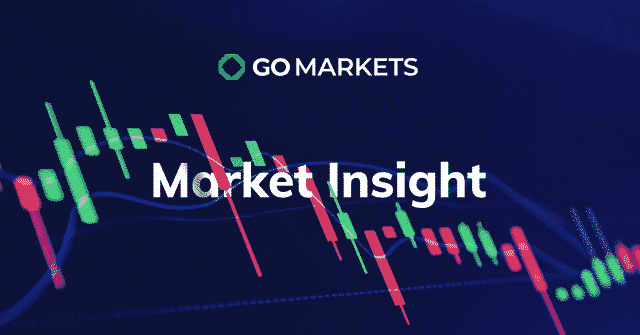

US indices were down today as Jerome Powell indicated that the Federal Reserve is going to increase interest rates at a higher and faster rate than currently in place. US equities dropped after Powell’s speech. Ultimately the major indices ended relatively flat by the close of trading.
The Nasdaq closed down 0.40% after taking a breather from its recent buying momentum. The Dow Jones was dragged down by Boeing after a 737-plane crash in the mountainous Guangxi region in China. The Boeing share price saw a 5.74% drop on the opening before recovering a little to close the day down by 3.60%.
The S&P500 was also choppy as it reacted the Jerome Powell’s speech but finished flat. The FTSE 100 showed gains as an uplift in commodities supported the index with oil spiking. This provided strength for the UK’s biggest oil companies BP and Shell with both rising by 3%.
The FTSE ended the day up 0.51% whilst the DAX was down 0.60%. Commodities Brent Crude Oil made a powerful move overnight rising 7.91% to 116.33 USD. This came as European Union officials debated whether to place sanctions on Russia's lucrative energy sector to pressure the country over its invasion of Ukraine.
An embargo on Russian oil similar to what the USA and the UK have done may have drastic implications for the EU in which 40% of its gas is imported from Russia. Natural gas prices also continue to remain in the upper end of their recent price range. Gold remains near its recent support levels ending the day at 1929 USD per ounce.
Cryptocurrency Bitcoin had a choppy day as BTC/USD ended flat overall. Ethereum was the better performer closing the day with a 1.87% rise. The ETH/USD continues to hold just below the $3000 resistance level.
FOREX The EUR/USD continued to be rejected at the $1.08 level after the speech from the Federal Reserve spurred USD strength. The AUD/USD has not been able to break through its recent highs of $0.74 as it proved a flat day for the pair after the previous day’s strong moves. The USD has continued its strong move against the JPY as it climbed another 0.27%.
The JPY has continued to struggle against most other currencies. The GBP/JPY has closed in on its recent area of support 157.00-158.00 JPY as seen below as it looks to potentially break out.


The stronger-than-expected US non-farm employment change data release last week saw the DXY climb strongly higher, beyond the 103 price level. With markets now anticipating that the US Federal Reserve could reinforce its hawkish stance, further upside is expected for the DXY. On the other hand, uncertainty rises over the Bank of Japan’s (BoJ) monetary policy stance following the surfacing of rumors that Masayoshi Amamiya was approached to succeed the current BoJ Governor, Haruhiko Kuroda.
The appointment of Amamiya as governor could likely see the BoJ continue with its ultra-easy monetary policy, ultimately leading to further weakness for the Japanese Yen. Technical Overview The recent change in sentiment of the DXY has led the USDJPY to pause on the previous downtrend, finding support at the 127.00 price area. The current retracement of price to the upside has seen the USDJPY break above the bearish trendline formed in November last year.
If this upward momentum continues and the USDJPY breaks above the 133.50 price level, which coincides with the 23.60 Fibonacci retracement level, this could signal confirmation for a bullish correction. The USDJPY could continue to trade higher, with the bullish momentum supported by the divergence in the Moving Average Convergence & Divergence (MACD), toward the target price level of 142.50 price level, formed by the 61.80% Fibonacci retracement level and previous swing high from November 2022.

